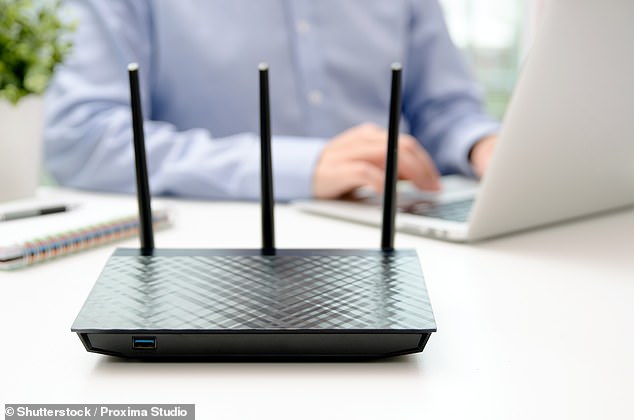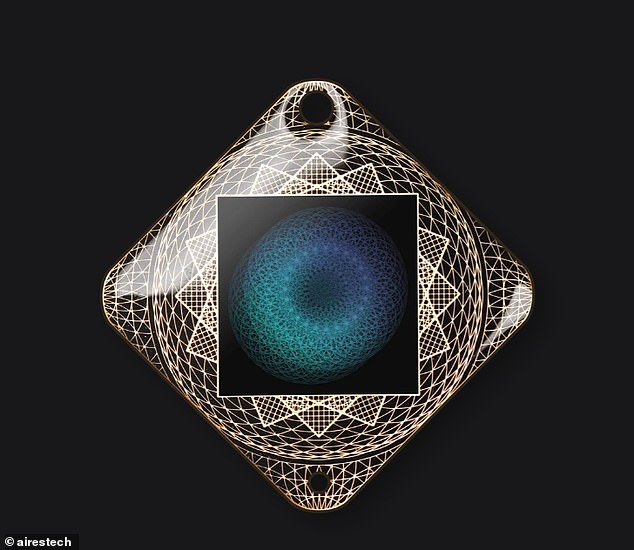Do Wi-Fi Signals Harm You? Experts reveal the truth – as Russell Brand flogs a ‘magic amulet’ he insists will protect you from ‘evil energies’ at airports for an extortionate price
From smartphone addiction to cybercrime, it’s no secret that spending too much time on the internet can be risky.
But are Wi-Fi signals themselves harmful to us?
In his latest bizarre video, disgraced comedian Russell Brand flogs a £180 ‘magic amulet’ which he insists will protect its wearers from the ‘evil energy’ of WiFi signals.
‘As you know, airports are places full of WiFi and all kinds of evil energies. Think of all the phones out there, all the signals, corrupted and corrupted. Luckily I wear this magical amulet from Airestech that protects me from all the different signals out there,” Brand says in the video.
So is there really any truth behind these bizarre claims?
In his latest bizarre video, disgraced comedian Russell Brand claims WiFi can be ‘deadly’ to sell £180 ‘magic amulet’
What are WiFi signals?
Wi-Fi stands for Wireless Fidelity and is a communications network technology that allows computers and phones to communicate remotely.
What Mr. Brand is likely referring to in his latest video are the radio signals that Wi-Fi devices use to communicate.
These are energy waves between 2 gigahertz and 5 gigahertz on the electromagnetic spectrum – about the same range as the waves used in microwaves.
Like all forms of electromagnetic energy, this means that the signals generated by Wi-Fi networks are a form of radiation.

Wi-Fi stands for Wireless Fidelity and is a communications network technology that allows computers and phones to communicate remotely
If Wi-Fi is a form of radiation, can it cause cancer?
While it sounds like radiation similar to microwaves would be dangerous, the current scientific consensus is that Wi-Fi poses no risk to human health.
The crucial reason for this is that Wi-Fi is a type of radiation called ‘non-ionizing radiation’.
This is a name used to refer to types of radiation that do not contain enough energy to damage our cells or DNA.
One of the biggest concerns people may have about Wi-Fi radiation is that it could lead to an increased rate of cancer.
When our bodies are hit by strong radiation, the links in our DNA are broken, leading to cell mutations that cause cancer.
Luckily for us, because Wi-Fi is non-ionizing, it doesn’t break or damage our DNA, so there’s no physical mechanism by which it could increase our risk of cancer.

Russell Brand claims the Lifetune Flex (pictured) can protect you from WiFI signals. However, there is no evidence that WiFi is harmful at all
What’s the evidence?
Currently, there is no evidence that exposure to Wi-Fi, phone signals, or other forms of non-ionizing radiation is associated with an increased risk of cancer.
Maria Feychting, professor of epidemiology at the Karolinska Institutet in Stockholm, previously told MailOnline: ‘Currently there is no strong evidence that exposure to electromagnetic fields while using mobile phones is associated with adverse health effects.’
In 2012, a comprehensive report from the British Health Protection Agency found that there was no evidence that radio frequency signals were carcinogenic.
Likewise, further studies conducted in 2016 by the Institution of Engineering and Technology concluded that there was no evidence of adverse health effects.
This year, the WHO reviewed more than 5,000 studies, including 63 observational studies in humans, and found that there is no link between phone use and cancer.
Lead author Professor Ken Karipidis from the Australian Radiation Protection and Nuclear Safety Agency said at the time: ‘We have concluded that the evidence shows no link between mobile phones and brain cancer or other head and neck cancers.’

The WHO’s comprehensive review of 5,000 research articles concluded that there was no evidence that exposure to radio frequencies from mobile phones or computers was linked to cancer (stock image)
Some studies have claimed that an increased risk of cancer has been found due to exposure to non-ionizing radiation, especially if you hold a phone to your head.
For example, the Bio-Initiative Group concluded in 2007 that radiofrequency radiation, even at very low levels, was linked to an increase in cancer rates.
A separate 2020 study from UC Berkeley also claimed that using a cell phone for just 17 minutes a day for 10 years increases the risk of developing cancerous tumors by as much as 60 percent.
However, these findings are highly controversial and many researchers have pointed out serious shortcomings.
For example, scientists found that the Bio-Initiave group’s research included “a number of chapters written by individual authors, apparently without mutual consultation or discussion.”
Cancer Research UK also rejected the results of the UC Berkley study, saying: ‘Mobile phone use does not increase the risk of cancer.’

Although smartphones emit radiation, the number of brain tumors has not increased at the same rate as smartphone ownership. This is compelling evidence that the radio frequencies associated with smartphones do not cause cancer. This graph shows the smartphones that emit the highest levels of radiation
Do we have proof that Wi-Fi is safe?
On the other hand, we have good reason to believe that Wi-Fi does not cause cancer.
Cancer Research UK (CRUK) points out that mobile ownership in Britain increased by 500 percent between 1990 and 2016.
If radio frequencies produced by wireless devices cause cancer, we should expect a similarly large increase in brain cancer and other cancers.
However, between 1990 and 2016, brain tumor rates have remained remarkably flat.
Although there has been some increase in the diagnosis of brain tumors, this also coincides with significant improvements in diagnostic capabilities.
As many researchers have noted, this is a good indication that Wi-Fi has little or no impact on cancer rates.

Russell Brand recently converted to Christianity and has been trying to sell himself as a religious influencer. Bran (right) was pictured performing a baptism in his underpants last month
Can WiFi be harmful in other ways?
Some argue that even if WiFi doesn’t cause cancer in any way, it can be harmful in other ways.
For example, exposure to radiofrequency fields has been found to affect living organisms by heating or vibrating molecules or causing oxidative stress.
Very high frequencies can cause tissue heating and even burns, while powerful low frequencies can cause nerve stimulation.
This could possibly mean that Wi-Fi signals can lead to damage that is not caused by cancer.
In 2014, researchers from the University of Exeter suggested a possible link between mobile phone exposure and poorer sperm quality.
However, the researchers admitted that more research was needed because the evidence was vague.
But because of the potential risks, government agencies have introduced legal thresholds to limit people’s exposure to high levels of non-ionizing radiation.

The 49-year-old is now the face of the Airestech product, which claims to protect the user from ‘electromagnetic fields’. However, WiFi-enabled devices produce radiation levels well below safe thresholds, so there is no cause for concern
For example, the government of Canada sets limits that are fifty times lower than the threshold for possible adverse effects.
That means that even if you stand next to a radio antenna, you are exposed to significantly lower amounts of radiation than has been shown to cause damage.
It is also sometimes said that we do not have enough evidence to say whether radio frequencies such as Wi-Fi cause harm.
However, this is simply not the case, as the WHO estimates that 25,000 studies have now been published on the subject of non-ionizing radiation.
That means we have a better idea of the harm from WiFi than most of the chemicals we’re routinely exposed to.
Overall, this gives us a good indication that Wi-Fi isn’t harmful to people and there’s no need to buy a £180 chain to protect yourself.
